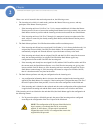
23
Chapter 2:
SFE2000/SFE2000P Gigabit Ethernet Switch Reference Guide
Chapter
2
• If a 48-port unit replaces a 24-port unit, then the first 24 ports of the incoming unit are
configured according to configuration of the ports of the failed unit. The remaining ports of the
incoming are configured according to the default settings.
• If the units have uplink ports, then the first uplink port of the incoming unit is configured
according to the configuration of the first uplink port of the failed unit.
Replacing a Failed Stack Master Unit in an Operational Stack
When the Stack Master unit fails, the stack Backup Master, using the Master Discovery process,
discovers that the Stack Master unit no longer responds. The Backup Master takes over as the Stack
Master. The Backup Master (now the Stack Master) directs all other stack members to route unit-to-unit
traffic around the failed unit using the ring topology of the stacking connections. Concurrently, the
Backup Master notifies the system administrator of the failure by sending SYSLOG messages and
SNMP traps.
Because all traffic has been routed around the failed unit, when it is disconnected from the stack, the
stack continues to run as long as all other stacking connections are left intact.
When a new unit is inserted in the stack and powered on, the following occurs:
1. The incoming unit, which is in stack mode, performs the Master Discovery process, and may
participate in the Master Election process.
• If the incoming unit has a Unit ID of 1 or 2 (it is a master-enabled unit) it initiates the Master
Election process. However, because the running stack Backup Master has a longer runtime (if it
has been running for more than 10 minutes) it remains the Stack Master and the incoming unit
does not become the new Stack Master. This can cause an incoming unit with a Unit ID of 1 to
serve as the stack Backup Master, while the current unit with the Unit ID of 2 remains the active
Stack Master.
2. The Stack Master performs Unit ID allocation and the conflict resolution process.
• If the incoming unit did not have an assigned Unit ID (that is, it is in factory default mode), it is
assigned the lowest available Unit ID by the Stack Master. We recommend that you use the
automatically-assigned unit ID mode because it provides better resiliency to the stack.
• If the incoming unit already has an assigned Unit ID, and that Unit ID is unused in the current
stack, the incoming unit keeps its assigned Unit ID and the Stack Master applies any
configuration relevant to that Unit ID to the incoming unit.
• If the incoming unit already has an assigned Unit ID, and that Unit ID conflicts with a unit ID in
the current stack, the Stack Master allocates a new Unit ID to the incoming unit, giving it the
lowest available Unit ID. However, if the incoming unit has a manually assigned Unit ID, the
Stack Master cannot change it. If the incoming unit cannot be assigned an available Unit ID,
then it is shut down and is not joined to the stack.


















